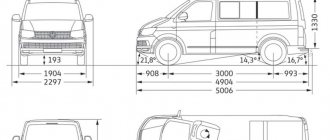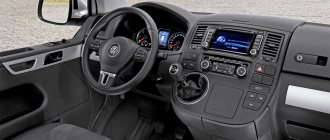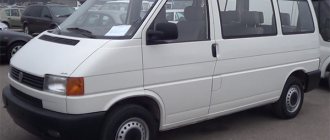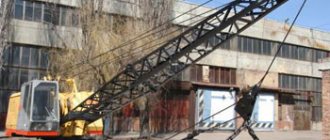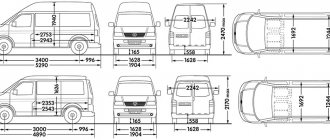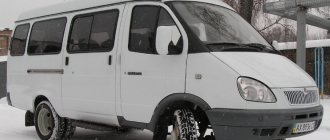The five-cylinder ACV engine, which was installed on the well-known and popular Volkswagen Transopter T4, a diesel engine with a volume of 2.5 liters and equipped with one turbocharger, the approximate number of cars produced with this engine was about ~400,000 units and was produced during from 1995-2003
We have all seen the TDi emblem on the VW T4 radiator grille, so if you see a TDI on the grille where the letter “I” is silver, then you know that this is a representative with an ACV engine
see also
Comments 48
Tell me the model of the internal combustion engine 2.5 tdi 110kw 150hp. And how has he proven himself? Tell me. They offer a caravel with the same engine from 2001
The T4 has 1.9D and 1.9TD - the difference is 8 hp. In my opinion, the 2.5 TDI is best, I drove this one for 5 years, the speedometer showed 460 thousand km and this does not take into account what was twisted when imported to Ukraine .I didn’t go to the engine at all.
Impressive numbers, thank you!
I have a 1.9 turbo. abl. I've been going for 3 years. I carry up to 500kg. Of course, it’s not fast on the highway... on average 90 km, normal speed... and I invest 6 liters... it goes normally in the city in traffic. With a turbine the engine is much livelier. no problems with it... the old owner killed the engine. I had to make capital. Much cheaper to repair than other engines. so it's up to you to decide. it all depends on finances. and how much do you plan to spend on repairs later? 1.9. The service is not expensive and not whimsical. but there are pros and cons in any engine... a weak engine is cheaper to maintain but slow-moving. You can, of course, go to 140. But it starts to consume oil and fuel consumption increases... a more powerful engine is faster but more expensive to maintain...
I have a 1.9 turbo. abl. I've been going for 3 years. I carry up to 500kg. Of course, it’s not fast on the highway... on average 90 km, normal speed... and I invest 6 liters... it goes normally in the city in traffic. With a turbine the engine is much livelier. no problems with it... the old owner killed the engine. I had to make capital. Much cheaper to repair than other engines. so it's up to you to decide. it all depends on finances. and how much do you plan to spend on repairs later? 1.9. The service is not expensive and not whimsical. but there are pros and cons in any engine... a weak engine is cheaper to maintain but slow-moving. You can, of course, go to 140. But it starts to consume oil and fuel consumption increases... a more powerful engine is faster but more expensive to maintain...
What should I change in terms of capital?
Exclusively 1.9 TDI, and even better than 2.5TDI. The 2.4 is a problematic engine - I've heard from many people.
Volkswagen T4 is considered very reliable. He selflessly resists the influence of time. But is he as good today as he used to be? What faults are hidden in its design?
Volkswagen transporter T5
New, modern and not as long-lived as its predecessor. Engine problems begin much earlier. Repairing a VW T5 costs a pretty penny.
The symptoms are almost the same, but begin earlier. On the one hand, motorists like that the diesel engine pulls well at low engine speeds, but on the other hand, this nuance also has its downside. At low speeds, the oil pump does not provide normal oil pressure, which leads to a thinning of the oil layer on the mating friction pairs, transferring the friction mode to borderline, or even semi-dry. This, in turn, entails a change in temperature conditions and leads to exceeding the yield strength of the metal - in other words, to the destruction of the surface layer, making it fragmentary. The first stone in the wear and tear process has been laid. Then, metal shavings begin to accumulate in the engine from the contact spots of mating parts with the lost protective layer. Further consequences - from increased engine oil consumption to its probable jamming if timely measures are not taken - are not difficult to predict.
In addition, the reasons for engine wear, despite its modernization, which, first of all, consisted of a new block made of a spray-coated aluminum block, are low-quality fuel and prolonged idling. Which leads to incomplete combustion of diesel fuel, the formation of soot and coke. And as a result, the destruction of the protective layer on the cylinder block.
[ads1]
Solutions:
- expensive repairs;
- use of fuel combustion catalyst Fuelex Diesel.
The diesel fuel additive Fuelex optimizes combustion processes. The fuel burns in the combustion chamber and is not exhausted, so the engine and rings do not coke, the afterburning catalyst and particulate filter last several times longer.
The use of repair and restoration compounds for the engine in the case of the Volkswagen T5 will not stop wear, since the reaction on which the operating principle of the RVS-Master technology is based will not occur. For motors made of an aluminum block, it is only possible to micro-grind the friction surface in the cylinder and remove carbon deposits and deposits, which also has a beneficial effect on extending the service life and increasing pneumatic tightness. But a metal-ceramic protective layer is formed on the crankshaft and camshafts.
Model history
The Volkswagen T series has a very long tradition. The first such car was created back in the late 40s of the twentieth century. It was designated Typ 2 (T1). The successor to T2 appeared in the second half of the 60s and spent about 10 years on the assembly line. In 1979, the time came for the next generation - T3, which existed until 1992. In South Africa, its production continued for another 12 years.
In the early 90s, the design and construction of the T3 were already very outdated, and Volkswagen released the T4. The new generation was innovative not only in terms of styling, but also in terms of powertrain. It was in this model that the Germans decided to abandon rear-wheel drive, replacing it with front-wheel drive. Those interested could purchase the all-wheel drive version of Syncro 4×4 for an additional fee. The location of the engine also changed: it was moved from the rear of the car to the front.
The minibus was offered in four main versions - Transporter, Carravella, California and Multivan. The Transporter is a utilitarian basic van. The remaining versions are luxury passenger models.
In the fall of 1995, the Volkswagen Transporter received a new diesel engine, and the Carravelle and Multivan versions underwent a light facelift. The most noticeable differences are a new grille, headlights and hood, giving the van a more aggressive appearance. There's a new steering wheel inside, and there are a few minor changes to the dashboard. Gradually, updates appeared in other versions. Volkswagen T4 was assembled until 2003 in Germany, Taiwan and Indonesia.
Engines
R5 2.5 (110-115 hp)
R5 2.4 D (75-78 hp)
R5 2.5 TDI (88, 102-151 hp)
Minibuses usually do not have a very wide range of powertrains. But Volkswagen did not skimp, offering a large selection of engines. Diesel units have become the most popular, of course. No wonder, vans with a petrol engine under the hood consume too much fuel, and for users of vehicles of this type, low consumption is very important.
Diesel engines, like the car, come from the 90s. The higher the power, the better the dynamics, but also the more frequent the service visits. Weaker R4s have great difficulty accelerating the Transporter. Until recently, these engines were considered very reliable, but today, due to gigantic mileage, they are increasingly beginning to crumble. 1.9 D and 2.5 TDI (150 hp) may require major repairs after 300-350 thousand km. Other diesel engines easily last 450-500 thousand km.
Since the car is already many years old, malfunctions can occur with any of the modifications. Old diesel engines primarily suffer from fuel leaks and fuel injection pump failure. In addition, not only the glow plugs often fail, but also the glow control system itself. In younger TDIs, the turbocharger, flow meter and fuel injection system fail.
If you do not want to spend a lot of money on repairs at a car service center, then you should pay attention to gasoline engines. Their resource is over 500-700 thousand km. They break down much less often, but the savings on repairs are simply burned along with the fuel during trips. Regardless of the chosen version of the gasoline engine, you should not hope that fuel consumption in the city will be less than 10 liters per 100 km. The most powerful V6 easily burns more than 15 l/100 km there.
Unfortunately, gasoline units are not completely free from technical faults. Most often this concerns auxiliary equipment: generator, starter, ignition coils and all kinds of sensors, including lambda probes. Oil leakage also occurs. In severely neglected examples, a major engine overhaul may be necessary.
The petrol AAS (2.0/84 hp) is considered the most capricious. It's all about the Digifant injection control system. Sometimes it starts to play tricks: either fuel consumption suddenly increases, or interruptions occur in the engine when the air temperature is near zero. A solution was found - replacing the injector with a VAZ “January”. The cost of such an alteration is about 30,000 rubles.
Fuel consumption
Diesel fuel of inadequate quality causes irreparable damage to both engines. Incomplete combustion leads to premature aging of the oil, loss of its chemical and physical properties, and destruction of the base additive package. The presence of water and sulfur leads to the formation of sulfuric acid, which causes corrosion. Not only parts of the CPG are susceptible to corrosion, but also injectors. In addition, the vanadium content in low-grade fuel causes vanadium corrosion of injectors and sprayers. The formation of carbon deposits and blockages affect the operation of the nozzles and the pressure reducing valve, which causes malfunctions in the operation of the power unit, increased fuel consumption, and reduces the service life of the engine. Using the DP3 composition will not only clean the injectors of carbon deposits, but also restore pressure in the fuel system. DP3 injector flushing is suitable for all types of common rail systems. The use of flushing allows you to reduce fuel consumption on a Volkswagen transporter, restore pressure, make it easier to start a diesel engine, increase power, eliminate uneven operation and idle failures. Also, the effect of using injector cleaning, which includes serpentinite minerals, is to compensate for wear and form a protective layer on the valve plates, which is especially important for the T5, which has one of the disadvantages of breaking the wells in the GB under the injector pump.
Transmission
The Volkswagen T4 forever broke with the established tradition: rear-wheel drive and an engine located behind the rear axle. The minibus became front-wheel drive with a motor in the front. Power is taken from the engine using a 5-speed manual or 4-speed automatic.
In the all-wheel drive version of Syncro 4×4, the distribution of torque between the axles is carried out through a viscous coupling, which, when the front wheels slip, connects the rear ones. The presence of Syncro will require additional operating costs: a suspended bearing and an elastic driveshaft coupling, gearbox seals or a humming rear gearbox.
Some owners are looking to convert regular versions into all-wheel drive. Fortunately, such modernization is quite possible and can be successfully solved in specialized services.
Typical problems and malfunctions
If you purchase a Volkswagen T4 from the first years of production, then a thorough inspection of the body for corrosion is necessary. Rust often appears on the trunk door, rear fenders, hood, on the windshield frame and vertical seam on the left side of the body, as well as on the sliding door area. The younger the specimen, the lower the risk of “rotting”.
Another weak point of the German delivery truck is leaks in the power steering system. Many cars relatively often require replacement of steering rods, repair of the power steering pump and steering rack.
The struts and stabilizer bushings that wear out most quickly in the suspension. Ball joints, silent blocks of levers and shock absorbers last more than 100-150 thousand km. Russian roads contribute to rapid wear of wheel bearings. After all, nothing lasts forever!
Gearboxes are also not characterized by excessive endurance. In the case of automatic transmissions, after 200-250 thousand km, the torque converter, hydraulic locking clutch, valves in the valve body and solenoids fail. For repairs you will need at least 50,000 rubles. A manual transmission clutch (15-25 thousand rubles) will last 250-350 thousand km. In the mechanics themselves, the 5th gear gears, bearings and synchronizers wear out.
Weight and dimensions characteristics
The weight in early versions is 7700 kg, and in later versions – 9000 kg.
Thanks to the width of the track shoes of 420 mm, the ground pressure of the latest modifications of the machines does not exceed 0.47 kg per square centimeter. At an acceptable level and dimensions. With a length of 4445 mm, the T-4 has a width of 1962 mm and a height of 2585 mm. Summarizing the reviews of those who have ever used modifications of the popular model, we get a picture of the advantages and disadvantages of the tractor.
Advantages
Positive traits:
- Cross-country ability is ensured by the traction characteristics of the engine, the design of the suspension and the selection of gear ratios of the gearbox.
- A powerful heating system that allows you to operate the equipment even in severe frosts.
- Visibility and tightness of the cabin on cars of recent years of production.
- The resource is supplemented by the availability of spare parts. After all, production of the model continued until 1988, and the engines of the A-01 family are still produced today.
Flaws
- Small safety margin of standard tracks.
- Low resource and difficulty of replacing friction belts.
The T-4 tractor is more difficult to maintain than other tractors produced simultaneously with it in the USSR. But this is not yet a reason to refuse to use a proven machine that is still found on farms.
We continue our series of articles about tractors. If you are interested in this topic, read on and you will learn a lot. What advantages does the T-25 tractor have? How is the gearbox arranged on the T-40?
Engines
The VW Transporter T4 2.4D diesel engine has proven to be quite reliable in operation. In addition, it is well adapted to low quality diesel fuel. Before overhaul, the engine runs 300-400 thousand km without problems, and only during these runs does such a specific disease as a breakdown of the brake booster vacuum pump appear. The malfunction can be determined by the characteristic knocking sound of the engine. However, there is no need to rush to change the pump right away: it will still be able to work for some time if the pump plunger is rotated 180°. It is also quite difficult to adjust the fuel injection pump - to set the injection advance angle, fortunately this is rarely required.
Another big plus of the T4 is the spacious engine compartment, which makes servicing the engine quite easy.
The VW Transporter T5 2.5TDi engine is more powerful, torquey and... capricious. For excellent dynamics, owners have to pay quite a lot. Let's start with engine oil: only oil with 506.01 approval is suitable for this engine - and there is nothing else like it except the expensive original oil. You cannot use any other motor oil - the coating in the cylinders wears out quickly.
Another headache is pump injectors, which tend to fail when using low-quality fuel or after 150-250 thousand km. A new injector costs about $1 thousand, and there are five of them! Another engine disease is jamming of the overrunning clutches of the generator and air conditioner, as well as the freewheel of the air conditioner. Another problem is the design of the engine, namely the absence of a timing belt or chain: all attachments are driven by clutches that need to be changed on time, otherwise you may lose the generator and air conditioner, and along with the latter, the safety clutch that comes with the compressor .
By the way, it is impossible to replace couplings, as is done with a belt, in “field conditions”: you need to disassemble half of the engine - preferably at a service station and with the help of a qualified specialist.
Well, the most common disease is the failure of the water pump or “pump”. Yes, the spare part is quite reliable and will last about 200 thousand km, then it needs to be changed, otherwise the consequences are fraught with consequences for the entire engine. The “pump” begins to leak, the oil mixes with antifreeze and loses its lubricating properties, after which increased wear of engine parts begins. To complete the picture, it is worth noting the frequent breakdowns of the turbine.
Volkswagen transporter T4
Old, good and reliable diesel. Problems with the engine begin after a mileage of 300 thousand km. Symptoms:
- oil consumption;
- blue white smoke;
- decreased cravings;
- uneven work;
- The engine will not start.
Causes:
- prolonged idling;
- low quality fuel;
- turbine wear;
- wear of injectors;
- compression drop.
Solutions:
- repair and replacement of failed components and parts;
- use of repair and restoration compounds.
How the Volkswagen T4 diesel engine compares favorably with the T5 is the block material – cast iron. RVS-Master technology makes it possible to restore and protect against wear motors made from this material. Why is that? The principle of operation is based on the reaction of replacing iron atoms with magnesium atoms, which are part of serpentinite minerals of natural origin. As a result of the reaction, a metal-ceramic protective layer is formed on the friction surfaces, which has increased hardness, low friction force, anti-corrosion properties, and fire resistance. For worn-out engines and with high mileage, it becomes possible to compensate for wear on mating friction pairs, restore pressure in the oil system, increase compression, make starting easier, reduce oil consumption due to waste, and increase the service life of the entire unit.
Chassis
Problems with the chassis of the VW Transporter T4 2.4D are observed only in careless users who load bags of cement into the cabin right under the roof. There are plenty of such owners, so the service life of the T4 chassis is an ambiguous value. For example, during active cargo transportation, replacement of stabilizer bushings will be required every 30-40 thousand km, silent blocks of the lower arms will last 60-80 thousand km, ball joints - about 50 thousand km. The silent blocks of the upper control arms are practically eternal. The resource of the rear shock absorbers is about 120 thousand km, but due to constant overloads they can only last half of this period. Steering rods last 60–70 thousand km.
The VW Transporter T5 was noted for frequent failure of the steering rack, which may not last even 35 thousand km. The front stabilizer bushings last about 30 thousand km, the rear bushings - about 60 thousand km. Ball joints - no more than 50 thousand km. The service life of the shock absorbers is close to 100 thousand km, again depending on how the owner will load his minibus.
Body
VW Transporter T4 is well protected from corrosion; mainly cars that have been in an accident “bloom”. However, under the influence of our winters and reagents, rust can appear on the front wheel arches, under the sills, and also on the rear door.
T5 has much more problems. Owners complain about the car's poor paintwork, and rust appears even on relatively new cars - its main foci are located on the arches, around the door handles and the trunk lid.
As a result, it turns out that although the VW Transporter T5 is superior to the previous generation in comfort and dynamics, it is significantly inferior in reliability. This is no longer a car you can fix yourself. The minibus is demanding on the quality of fuel, timely replacement of spare parts, and the quality of engine oil. Therefore, on the market, a strong T4 is more expensive than the T5 of the first years of production.
Brief characteristics of the T4 Conveyor family
Strict and conservative, simple and practical, the Volkswagen Transporter T4 has appealed to consumers all over the world. This is one of the most popular vans of this class of all time in Europe. Over the years of production of this model, more than ten million of these cars were sold!
A wide selection of modifications, configurations and complete sets of the T4 Transporter made it popular among traders or middle-class businessmen (using it as a working delivery van); and among people who buy a multifunctional car for recreation and travel.
The popularity of the Transporter T4 as a “people’s” van in Russia can be the envy of most manufacturers of commercial light-duty vehicles - the number of T4s in our country exceeds 100 thousand vehicles (according to the analytical agency Autostat). This is only data on the T4, and the Russians also use the older, but still functional rear-wheel drive T3, and the more modern Transporter T5.
The predominance of cars produced in the 1990s demonstrates that our compatriots purchased them second-hand. Before the increase in customs duties, there were times when the T4 Transporter was brought from Europe in orderly columns.
Most T4 is in the central and northwestern regions. There is also a wide selection of them on the secondary market. In the Far East, Volkswagen is exotic, which is not surprising: the Japanese have long reigned supreme there.
In general, despite the extremely oversaturated competition in the class of light commercial vehicles, the Volkswagen Transporter T4 throughout its history has confidently surpassed in popularity most of its competitors - Europeans, Japanese, and Koreans.
Because, despite the relatively high maintenance costs, the Volkswagen Transporter T4 light-duty vans have proven to be very profitable to operate – largely thanks to their fuel-efficient engines, which provide an excellent cost-performance ratio with low fuel consumption.
In addition, as the authoritative magazine “Behind the Wheel” notes, “not the least advantage of this car is the hassle-free availability of spare parts. Today, the Volkswagen Transporter can be repaired even in a remote village. At the same time, it is not necessary to look for a part specifically for it - many things fit from Volkswagen cars, which are also replicated in millions of copies.
The name Transporter can be understood as any commercial vehicle Volkswagen T series, since they are all close relatives.
This generalization can be called forced. Because if you list all the names under which these cars officially rolled off the factory assembly lines each time, the article will take up a lot of space. It is difficult to find another car with such a complex and extensive designation scheme.
For example, since 1998, the company stopped using the name Transporter for the passenger versions of Caravelle and Multivan - it separated them (not technically, but purely formally) into independent models with their own families, but left them with the previous designation of the car generation - T4. And similar marketing decisions.
Opinions
Alexey 38 years old, Minsk
VW Transporter T4 1998
— Until I closed my business, T4 was a reliable assistant. It could easily fit several people and a dozen plastic windows. The 2.4D engine is torquey and drives just great. He “digested diesel fuel from under the tractor” and didn’t complain. The only thing is that the motor is afraid of overheating; during its operation it changed the “head” twice. The body does not rot, I did not apply any additional anticorrosive. I used the car for slaughter, so I overhauled the chassis once a year. My opinion is that the Transporter T4 is a good, reliable bus, but its time has passed. As an alternative, it is better to pay attention to the Renault Trafic and Opel Vivaro.
Sergey, 29 years old, Molodechno
VW Transporter T5 2.5 TDi 2005
— I bought the car with 173 thousand km mileage. Later it turned out that about 100 thousand km had been covered, although the T5 looked very neat. The first misfortune struck after 10 thousand kilometers - a whistle in the turbine. I drove like this for a month and ended up in the middle of the road: the impeller in the turbine fell apart. Winter came, the car began to work poorly at idle, but after it warmed up, everything returned to normal. At the service station, the mechanics pronounced judgment on the fuel-vacuum pump. There were no more malfunctions. In the chassis, I replaced two silent blocks in the front and rear, two ball blocks, installed new springs, that’s all. For better performance in winter I filled it with Hi-Gear. Overall the car is not bad, but the price of spare parts is simply killer.
